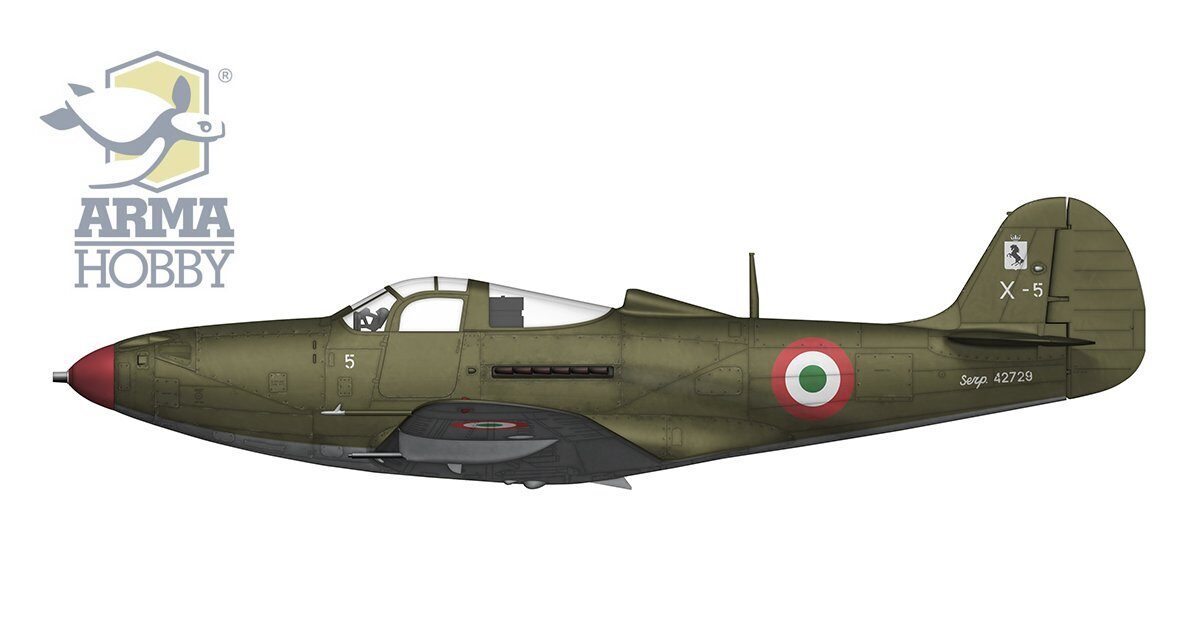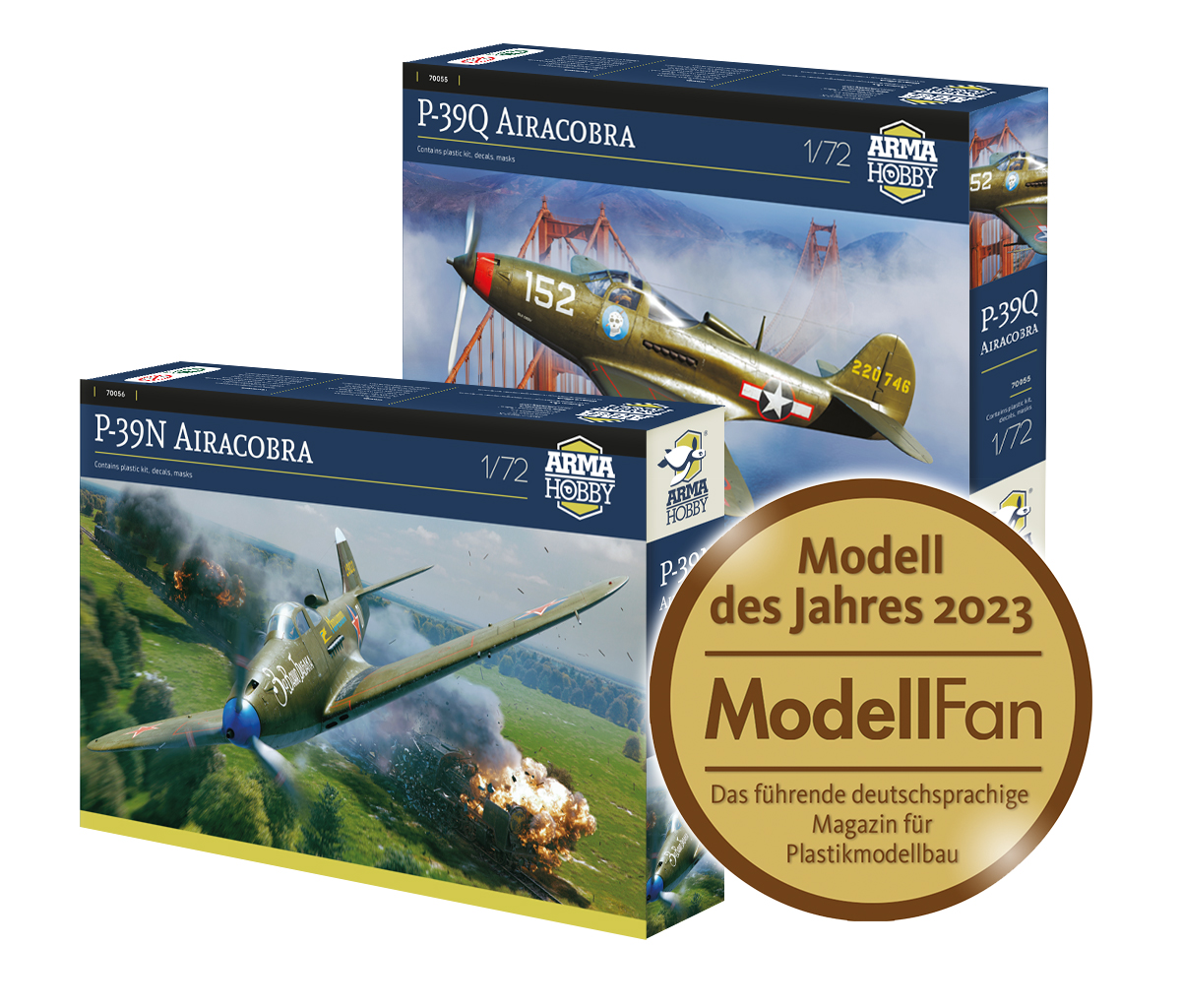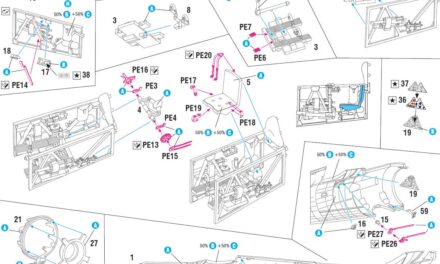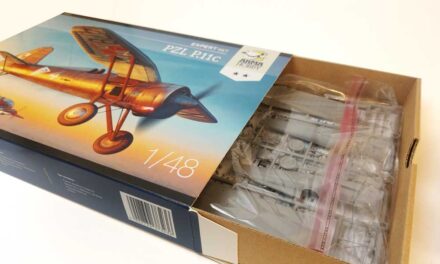One of the marking schemes of the P-39Q Airacobra model kit represents a fighter of the legendary Italian 10th Squadron, whose marking is a prancing horse – the personal coat of arms of the Italian Ace of Aces, Francesco Baracca, which, after the pilot’s death, was adopted by the famous automotive brand FERRARI. Gabriele Brancaccio – author of the book Il Meraviglioso – A brief history of Italian 9th Squadron, now described for us the history of 10th Squadron and service of its Airacobras.
We invite you to read!
The Squadron and the Flight of Aces
X. Gruppo (10th Squadron) was founded on 10 April 1917 in Pasian de Prato – UDINE -during the First World War. The command was entrusted to Major PIER RUGGERO PICCIO.
The Squadron’s main task was fighter operations and escorting bombers, as well as a reconnaissance over the enemy front. On the 1 May 1917, the 91st flight, for Italian equivalence is squadriglia, was formed on the field of S. Caterina – Udine. Among its pilots were some of the future Aces of Italian fighter aviation: RUFFO DI CALABRIA, GORINI, RANZA, OLIVARI and Francesco BARACCA. The squadrons of the Xth Group carried out escort, fighter and reconnaissance missions, both visual and photographic.
Due to the presence of numerous Aces, the 91st flight is known as the “ SQUADRIGLIA DEGLI ASSI ” (“The Aces’ Squadron”).

Francesco Baracca and his SPAD XIII fighter marked with prancing horse coat of arms
Francesco BARACCA took command of the flight in June 1917. He relocated the flight several times, particularly in the period of the great Austro-Hungarian offensive between 1917 and 1918.
In the spring of 1918, the unit became part of the “MASSA DI MANOVRA-SQUADRIGLIE”. The glorious days of the Italian offensive followed. During this period, Major Francesco BARACCA, the Italian Ace of Aces of the First World War, fell in combat, having achieved the highest number of enemy aircraft “kills” with 34 victories and the Gold Medal for Military Valour. At the end of the Great War, the group counted ten aces among its pilots with numerous aerial victories.
In December 1918, the group was disbanded and placed in the reserves.
Francesco Baracca’s horse

The 10th Squadron is reconstituted on 1 June 1931 at Campoformido – Udine, to form, together with its brother 9th Squadron, the 4th Terrestrial Fighter Wing.
The Squadron was made up of three flights, the 84th, 90th and 91st.
The aircraft supplied were FIAT CR 20s. After a short stay, the group moved to the field at Gorizia, where it will remain until the outbreak of the Second World War. They soon received the first FIAT CR ASSOs, an evolved model of the CR 20. A few years later, they received the first FIAT CR 32s, which had their baptism of fire within two years during the Spanish Civil War. Many of the Group’s men, pilots and specialists, took part in the events in Spain until the end of the conflict. It was in the early 1930s that the DECIMO (“The Tenth”) took as its badge the prancing horse, a personal marking of its hero: Francesco BARACCA.
From August 1939, the pilots of the X began the transition to a new aircraft, the Macchi C 200, which did not meet with approval because it proved to be heavier than the CR 32 and less performing in aerobatics. Soon, the entire group was equipped with the FIAT CR 42, a natural evolution of its predecessor, which was agile, fast enough, manoeuvrable and performed well in aerobatics.
Before the start of World War II, the group was transferred to Africa, to Libya, with stops in Tripolitania, then Cyrenaica and later to the borders with Egypt for the defence of Tobruk. Activities included escort, interdiction, protection of supply routes and troops, and free-hunting.
On both sides of the Mediterranean Sea
The climatic conditions of the area wore out the aircraft enormously, and much work was done by the S.R.A.Ms., aircraft and engine maintenance groups, who did true wonders to put aircraft damaged by fighting and sand or fine sandstorms back in the air. In December 1940, due to the British offensive, it was forced to retreat to safer positions, until it reached Tripolitania and left the efficient aircraft to the XXIII C.T. Squadron and was repatriated at the beginning of the new year.
Back in Gorizia-Merna, the group has been equipped since February with Macchi C 200s, whether of Macchi, Breda or SAI AMBROSINI factory. Having reached a good level of readiness, it took part in operations on the Yugoslav front, having the Ronchi dei Legionari headquarters as its base. Once the requirement ended at the end of spring, the unit deployed in Sicily, operating mainly from the Catania-Fontanarossa airfield.
It operated there until December against Malta island of the same year, when it received orders to return and move to the Campoformido headquarters. This allowed the group to be equipped with the first and promising Macchi C 202s recently delivered to the Fourth.
New aircraft, new commitments, so in April 1942, the group left for Sicily, where they operated first from Castel Vetrano and then from Gela. Having joined forces with the IX Squadron, they operated together against the island of Malta… The hot African front required great efforts so the entire Wing moved with various stages to Libya and then continued the advance towards Egypt and continued to stop at Fuka, a wine field at the front that in the summer of 1942 was at El Alamein.
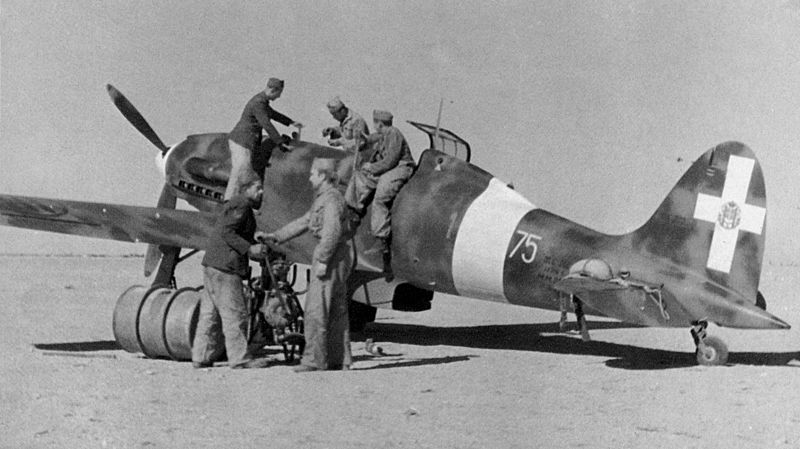
With this battle, the 4th Wing suffered numerous losses despite trying to fight effectively. The adversary forced them to retreat to safer bases leaving the operational aircraft to the 3rd Wing to allow it to hinder the advance of the British.
At the end of ’42, the group was repatriated to Italy, again to Campoformido. Once the rest period was over, the Tenth, equipped with new Macchi C 202s, was engaged in the defence of Northern Italy, then, out of necessity, moved together with the Ninth to the fields defending Rome.
The war reaches Italy
After the loss of the Libyan colony, the front moved towards Italy, so the concern of the High Command was that of the defence of home territory; for this reason, the entire wing was sent to the fields of Sicily, to be exact between Catania and neighbouring towns in the Sicilian plain, with even the first and few Macchi C 205s. Most of these were transferred from the 1st Wing, which returned to its Campoformido headquarters to reorganise and rest after exhausting months of fighting. The months of June and July 1943 were gruelling and full of sacrifice on the part of the men of the 10th Squadron, many pilots fell fighting against the numerous formations of fighter and bombardment aircraft that struck the entire island.
As a retreat to safer bases became necessary for the entire Wing, the X Squadron, with effective action, succeeded in its mission and reached Calabria, in the area of Castrovillari, the new home for the two groups of the 4th Wing. The first Macchi C 205s of the third production series also arrived, finally armed with the 20mm cannons that allowed a notable improvement and the possibility of being on par against the British SPITFIREs or other Allied aircraft such as the P40-Es or the early A-36s of the Americans or the P-38Es.
Alongside the Allies
With the general situation in the country increasingly compromised, the armistice of September 1943 was reached. The flock remained united and did not break up like other Regia Aeronautica divisions, thus compactly following the order of the legitimate government.

Macchi C.205 in Italian Allied colours
During this period, various movements see the group with the entire Wing move safely to other airports. Gioia del Colle- Bari- becomes the operational base for the two groups of the Wing. A short stay because then came the transfer: first to Brindisi and then to Galatina.
The activity with the C 205s did not give up and so they began to operate on the Balkan front in actions of escorting Allied bombers, armed reconnaissance, attacks on German troops, and various machine-gun attacks.

To shorten the distance to the targets to be hit, the group was transferred to Palata-Foggia and then to Nuova south of Campomarino. With the difficulty of procuring accessories and parts for the Macchi, the Allies come to the rescue by allowing them to use aircraft such as P-39 AIRACOBRAs in various subversions, but mostly in the N/Q versions, which were stored at various logistic depots in the Naples area. Another organisational change was made within the 4th Wing to bring the groups up to the same level as the Allied units belonging to the MEDITERRANEAN AIR FORCE.
Bell P-39 Airacobra in Regia Aeronautica
In summer 1944, the Regia Aeronautica received about 150 P-39Ns and Qs, most of which were taken from the 332FG of the 12th AIR FORCE.
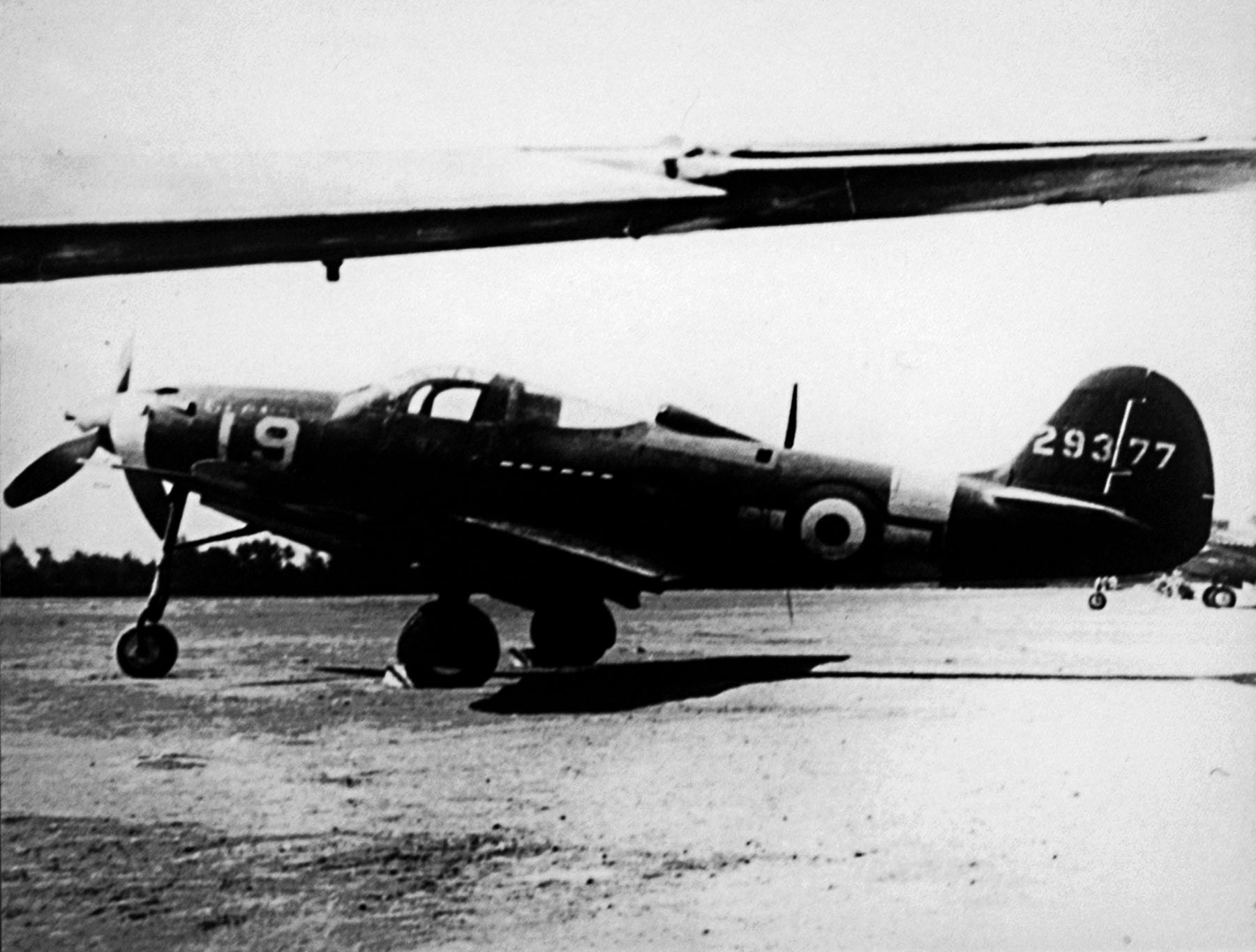
One of the first Airacobras transferred by US to Italians at Campo Vesuvio airfield. Remaining elements of US markings are visible
The versions differed in their wing armament of four 7.7mm for the N version and two 12.7mm in two nacelles for the Q version. The P-39 were assigned to the three groups of the 4th Wing and the first to receive the new machines and make the transition was the XII followed by the X and then IX. The Ninth made limited use as it was relegated to a reserve mass of men and aircraft for the two frontline-ready groups. During the transition to the new aircraft, there were a few fatal accidents among pilots who, although experienced, found it difficult to handle an aircraft with little agility according to American standards.

Airacobras of IX. (white horse) and X. Squadron (black horse). Photo: Worldwarphotos.info
Airacobras were used for tactical support, armed reconnaissance, visual reconnaissance, bombing, and machine-gunning on the Yugoslav front until the end of hostilities in May 1945. In total, the P-39s of the 4th performed 2970 hours of combat operations and 3629 hours for other purposes. Much was owed to the maintenance team that, through general overhauls, always ensured an adequate number of aircraft available despite the fact that corrosion in the tail section was found on two-thirds of the P-39Ns. With the end of the conflict and the arrival of the first P-38s at the wing in 1946, it was possible to decommission and use the AIRACOBRAs in school duties until the early 1950s, still at the Lecce base.
The 12th Group was reconstituted in January 1944, taking one squadron from the 9th Squadron, the 73rd, and one from the 10th Squadron, the 91st. Activity on the Balkan front slowed down due to adverse weather conditions and the difficulty of finding spare parts always ready, as the national industries were in the north of the country and under the control of the occupying Germans.
At the beginning of the summer, training on P-39s followed at the base of Campo Vesuvio, yes, close to the plain of Naples, behind Vesuvius, the Americans had set aside a fair number of such aircraft. With much sacrifice and self-sacrifice, the skilful and trained specialists of the Regia Aeronautica put many of the aircraft back in shape and ready to be used, taking from those in the worst condition all the good things they could find.
By popular demand, the group was named after Franco LUCCHINI, Medaglia d’Oro al Valor Militare (Gold Medal for Military Valour), who died in aerial combat in July 1943 in defence of Sicily. Hence the customisation of the group’s aircraft, which bear the signature of the Italian fighter ace in white on the nose cannon covers of the AIRACOBRA.
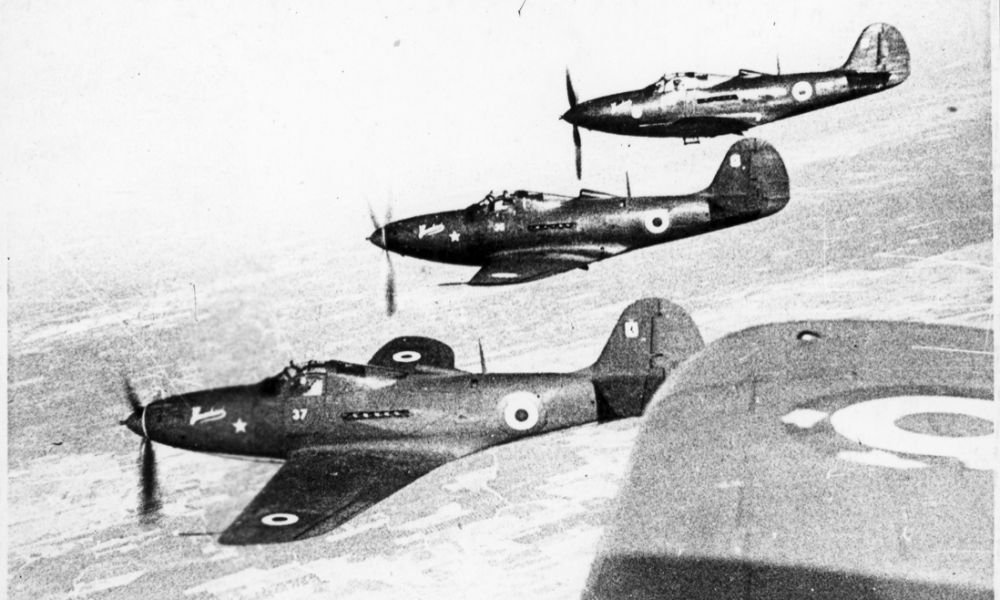
Airacobras of X. Squadron in flight. In the foreground two planes of the 84. Flight (marked with a star), in the background: 90. Flight (elephant marking)
In September, with the pilots ready to operate, the group and its flights returned to action on the Balkan front, now part of the Allied BALKAN AIR FORCE. The base from which the group operated was Leverano-Lecce and then returned in early 1945 back to Galatina-Lecce. Then, due to the increased distance from the front, unit was moved to the Canne field, even using the trampoline field on the island of Vis, near the coast of Yugoslavia. Once the conflict was over, the squadron remained in the Apulian bases, returning permanently to Galatina. In October 1945, the XII was disbanded and the two squadrons that made it up returned to their respective groups.

X. Squadron’s Airacobras, most probably on the Lecce-Galatina airfield, 1945
In the meantime, as the new year arrived, the first P-38L/Js arrived in the summer, beginning to replace the now elderly and battered P-39s. 1946 was also the year of the transfer of the 4th Wing to the Naples – Capodichino airport. 1947 brought with it the supply by the Allies of an adequate number of P-51Ds, or rather F-51Ds considering the birth and autonomy of the USAF and obviously the new designation of the aircraft. The flying equipment aged prematurely and so in 1951 the first DH 100 VAMPIRE arrived at the 4th, which gradually replaced the wonderful MUSTANGs at the two flight groups of the wing.
With Italy’s entry into NATO, the Armed Forces changed the organisation of the flying units, creating the aero brigades. Thus, on November 1, 1954, the wing was renamed the 4th Aero brigade and composed of three flight groups, the 9th, 10th and 12th. The 10th received two more squadrons, the 85th and 86th, ceding the 90th to the 12th Group. Subsequently, the aero brigade moved to the Pratica di Mare airfield in 1956 to receive the first American-supplied F-86 E SABREs. In March 1961, the X Squadron moved to Grosseto airfield, but in December of the same year it moved to Grazzanise-Caserta, where it continued to operate with SABREs.

F-104 ASA-M
In 1963, the first F-104Gs arrived at the aero brigade and this allowed the X Squadron to complete the conversion to the new machine in August 1964 and return to the Grazzanise base. In September 1967, the aero brigade was converted back into a wing and the X Squadron became part of the new 9th Fighter Wing F. BARACCA at the same airport. The years passed and in February 1973, the first F-104 S aircraft were received. Later came the updated version of the F-104 ASA, then followed by the ASA-M version in the 1990s. Eventually, on the basis of the X Squadron, the 104 is retired after forty years of service. The Tenth switched to a new, much more powerful machine, the F-16 ADF, with which it joined the 37th Wing at Trapani Birgi in March 2006. A brief situation that was followed by the transfer from 1 July 2010 to the 36th Wing at Gioia del Colle – Bari and the assignment of the latest generation EUROFIGHTER 2000 aircraft.

And the story continues
Gabriele Brancaccio is the author of the book Il Meraviglioso – A brief history of Italian 9th Squadron. Photos used in the article comes from Author’s collection and the Public Domain.
Order Airacobra in the Medal Promotion:
Virtual Editor, guest post publisher. When blog authors fall asleep he works unnoticed to improve website content quality.
This post is also available in:
 polski
polski


